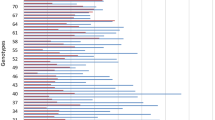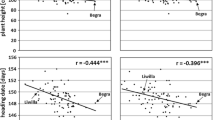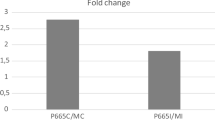Abstract
Ascochyta blight caused by Didymella pinodes (formerly Mycosphaerella pinodes) is one of the most important fungal diseases of pea (Pisum sativum) worldwide that can also infect the model legume Medicago truncatula. The objective of this study was to identify quantitative trait loci (QTLs) controlling resistance to D. pinodes in M. truncatula. Response to D. pinodes was studied under controlled conditions in seedlings of a population derived from the cross J6 × F83005.5, two M. truncatula lines that are, respectively, resistant and susceptible to D. pinodes. A combined map using two different recombinant inbred line populations was then used to identify the genomic regions bearing putative QTLs and to improve the position of the QTLs. A single QTL associated with resistance to D. pinodes was detected on linkage group 2, explaining up to 13 % of the total phenotypic variation for relative disease severity against the pathogen. Two simple sequence repeat markers, MTE80 and mtic890 (3 cM apart) were the ones most significantly associated with the QTL. These markers are located in bacterial artifical chromosomes AC119409 and AC125474, respectively, both of them overlapping on M. truncatula chromosome 2. The integration of QTL analysis and genomics in M. truncatula will contribute to the development of new markers and facilitate the identification of candidate genes for Ascochyta blight resistance.



Similar content being viewed by others
References
Abbo S, Frenkel O, Sherman A, Shtienberg D (2007) The sympatric Ascochyta pathosystems of Near Eastern legumes, a key for better understanding of pathogen biology. In: Tivoli B, Baranger A, Muehlbauer F, Cooke BM (eds) Ascochyta blights of grain legumes. Springer, Netherlands, pp 111–118. doi:10.1007/978-1-4020-6065-6_11
Ameline-Torregrosa C, Cazaux M, Danesh D, Chardon F, Cannon SB, Esquerré-Tugayé MT et al (2008) Genetic dissection of resistance to anthracnose and powdery mildew in Medicago truncatula. Mol Plant Microbe Interact 21(1):61–69
Arraouadi S, Chardon F, Huguet T, Aouani M, Badri M (2011) QTLs mapping of morphological traits related to salt tolerance in Medicago truncatula. Acta Physiol Plant 33(3):917–926. doi:10.1007/s11738-010-0621-8
Ben C, Toueni M, Montanari S, Tardin MC, Fervel M, Negahi A et al (2013) Natural diversity in the model legume Medicago truncatula allows identifying distinct genetic mechanisms conferring partial resistance to Verticillium wilt. J Exp Bot 64(1):317–332. doi:10.1093/jxb/ers337
Bouhadida M, Benjannet R, Madrid E, Amri M, Kharrat M (2013) Efficiency of marker-assisted selection in detection of ascochyta blight resistance in Tunisian chickpea breeding lines. Phytopathol Medit 52(1):202–211
Cho S, Chen W, Muehlbauer FJ (2004) Pathotype-specific genetic factors in chickpea (Cicer arietinum L.) for quantitative resistance to ascochyta blight. Theor Appl Genet 109(4):733–739
Choi HK, Mun JH, Kim DJ, Zhu H, Baek JM, Mudge J et al (2004) Estimating genome conservation between crop and model legume species. Proc Natl Acad Sci USA 101(43):15289–15294
Collard BCY, Mackill DJ (2008) Marker-assisted selection: An approach for precision plant breeding in the twenty-first century. Phil Trans R Soc Biol Sci 363(1491):557–572
Cruz-Izquierdo S, Avila CM, Satovic Z, Palomino C, Gutierrez N, Ellwood SR et al (2012) Comparative genomics to bridge Vicia faba with model and closely-related legume species: stability of QTLs for flowering and yield-related traits. Theor Appl Genet 125(8):1767–1782. doi:10.1007/s00122-012-1952-1
Davidson J, Kimber RE (2007) Integrated disease management of ascochyta blight in pulse crops. In: Tivoli B, Baranger A, Muehlbauer F, Cooke BM (eds) Ascochyta blights of grain legumes. Springer, Netherlands, pp 99–110. doi:10.1007/978-1-4020-6065-6_10
Delauré SL, Van Hemelrijck W, De Bolle MFC, Cammue BPA, De Coninck BMA (2008) Building up plant defenses by breaking down proteins. Plant Sci 174(4):375–385. doi:10.1016/j.plantsci.2008.01.008
Flandez-Galvez H, Ford R, Pang ECK, Taylor PWJ (2003) An intraspecific linkage map of the chickpea (Cicer arietinum L.) genome based on sequence tagged microsatellite site and resistance gene analog markers. Theor Appl Genet 106(8):1447–1456
Fondevilla S, Cubero JI, Rubiales D (2007) Inheritance of resistance to Mycosphaerella pinodes in two wild accessions of Pisum. Eur J Plant Pathol 119(1):53–58
Fondevilla S, Satovic Z, Rubiales D, Moreno MT, Torres AM (2008) Mapping of quantitative trait loci for resistance to Mycosphaerella pinodes in Pisum sativum subsp syriacum. Mol Breed 21(4):439–454
Frenkel O, Peever TL, Chilvers MI, Özkilinc H, Can C, Abbo S et al (2010) Ecological genetic divergence of the fungal pathogen Didymella rabiei on sympatric wild and domesticated Cicer spp. (Chickpea). Appl Environ Microbiol 76(1):30–39. doi:10.1128/aem.01181-09
Hagervall TG, Ericson JU, Esberg KB, Ji-Nong L, Bjork GR (1990) Role of tRNA modification in translational fidelity. Biochim Biophysi Acta Gene Struct Express 1050(1–3):263–266
Hospital F (2009) Challenges for effective marker-assisted selection in plants. Genetica 136(2):303–310. doi:10.1007/s10709-008-9307-1
Huettel B, Santra D, Muehlbauer FJ, Kahl G (2002) Resistance gene analogues of chickpea (Cicer arietinum L.): Isolation, genetic mapping and association with a Fusarium resistance gene cluster. Theor Appl Genet 105(2–3):479–490
Jensen ES, Peoples MB, Boddey RM, Gresshoff PM, Henrik HN, Alves BJR et al (2012) Legumes for mitigation of climate change and the provision of feedstock for biofuels and biorefineries. A review. Agron Sust Devel 32(2):329–364
Jourjon M-F, Jasson S, Marcel J, Ngom B, Mangin B (2005) MCQTL: multi-allelic QTL mapping in multi-cross design. Bioinformatics 21(1):128–130. doi:10.1093/bioinformatics/bth481
Julier B, Huguet T, Chardon F, Ayadi R, Pierre JB, Prosperi JM et al (2007) Identification of quantitative trait loci influencing aerial morphogenesis in the model legume Medicago truncatula. Theor Appl Genet 114(8):1391–1406
Khan TN, Timmerman-Vaughan GM, Rubiales D, Warkentin TD, Siddique KHM, Erskine W et al (2013) Didymella pinodes and its management in field pea: challenges and opportunities. Field Crops Res 148:61–77. doi:10.1016/j.fcr.2013.04.003
Kosambi DD (1944) The estimation of map distance from recombination values. Ann Eugen 12:172–175
Lagunes Espinoza LC, Huguet T, Julier B (2012) Multi-population QTL detection for aerial morphogenetic traits in the model legume Medicago truncatula. Theor Appl Genet 124(4):739–754
Lawyer AS (1984) Diseases caused by Ascochyta spp. In: Hagedorn DJ (ed) The compendium of pea diseases. American Phytopath. Soc, Minnesota, pp 11–15
Lagunes Espinoza LD, Julier B (2013) QTL detection for forage quality and stem histology in four connected mapping populations of the model legume Medicago truncatula. Theor Appl Genet 126(2):497–509. doi:10.1007/s00122-012-1996-2
Madrid E, Rajesh PN, Rubio J, Gil J, Millán T, Chen W (2012) Characterization and genetic analysis of an EIN4-like sequence (CaETR-1) located in QTLAR1 implicated in ascochyta blight resistance in chickpea. Plant Cell Rep 31(6):1033–1042. doi:10.1007/s00299-011-1221-9
Madrid E, Chen W, Rajesh PN, Castro P, Millán T, Gil J (2013) Allele-specific amplification for the detection of ascochyta blight resistance in chickpea. Euphytica 189(2):183–190. doi:10.1007/s10681-012-0753-6
Marino D, Peeters N, Rivas S (2012) Ubiquitination during plant immune signaling. Plant Physiol 160(1):15–27. doi:10.1104/pp.112.199281
Millan T, Rubio J, Iruela M, Daly K, Cubero JI, Gil J (2003) Markers associated with Ascochyta blight resistance in chickpea and their potential in marker-assisted selection. Field Crops Res 84(3):373–384
Millan T, Winter P, Jüngling R, Gil J, Rubio J, Cho S et al (2010) A consensus genetic map of chickpea (Cicer arietinum L.) based on 10 mapping populations. Euphytica 175(2):175–189
Mock H-P, Keetman U, Kruse E, Rank B, Grimm B (1998) Defense responses to tetrapyrrole-induced oxidative stress in transgenic plants with reduced uroporphyrinogen decarboxylase or coproporphyrinogen oxidase activity. Plant Physiol 116(1):107–116. doi:10.1104/pp.116.1.107
Mock H-P, Heller W, Molina A, Neubohn B, Sandermann H, Grimm B (1999) Expression of uroporphyrinogen decarboxylase or coproporphyrinogen oxidase antisense RNA in tobacco induces pathogen defense responses conferring increased resistance to tobacco mosaic virus. J Biol Chem 274(7):4231–4238. doi:10.1074/jbc.274.7.4231
Moussart A, Tivoli B, Lemarchand E, Deneufbourg F, Roi S, Sicard G (1998) Role of seed infection by the Ascochyta blight pathogen of dried pea (Mycosphaerella pinodes) in seedling emergence, early disease development and transmission of the disease to aerial plant parts. Eur J Plant Pathol 104(1):93–102. doi:10.1023/A:1008673914537
Moussart A, Onfroy C, Lesne A, Esquibet M, Grenier E, Tivoli B (2007) Host status and reaction of Medicago truncatula accessions to infection by three major pathogens of pea (Pisum sativum) and alfalfa (Medicago sativa). Eur J Plant Pathol 117(1):57–69. doi:10.1007/s10658-006-9071-y
Onfroy C, Tivoli B, Corbière R, Bouznad Z (1999) Cultural, molecular and pathogenic variability of Mycosphaerella pinodes and Phoma medicaginis var. pinodella isolates from dried pea (Pisum sativum) in France. Plant Pathol 48(2):218–229. doi:10.1046/j.1365-3059.1999.00323.x
Prioul S, Frankewitz A, Deniot G, Morin G, Baranger A (2004) Mapping of quantitative trait loci for partial resistance to Mycosphaerella pinodes in pea (Pisum sativum L.), at the seedling and adult plant stages. Theor Appl Genet 108(7):1322–1334
Prioul-Gervais S, Deniot G, Receveur EM, Frankewitz A, Fourmann M, Rameau C et al (2007) Candidate genes for quantitative resistance to Mycosphaerella pinodes in pea (Pisum sativum L.). Theor Appl Genet 114(6):971–984
Rose RJ (2008) Medicago truncatula as a model for understanding plant interactions with other organisms, plant development and stress biology: past, present and future. Funct Plant Biol 35(4):253–264
Roy F, Boye JI, Simpson BK (2010) Bioactive proteins and peptides in pulse crops: pea, chickpea and lentil. Food Res Int 43(2):432–442
Rubiales D, Fondevilla S (2012) Future prospects for ascochyta blight resistance breeding in cool season food legumes. Frontiers Plant Sci 3:27. doi:10.3389/fpls.2012.00027
Rubiales D, Castillejo MA, Madrid E, Barilli E, Rispail N (2011) Legume breeding for rust resistance: lessons to learn from the model Medicago truncatula. Euphytica 180(1):89–98
Samac DA, Graham MA (2007) Recent advances in legume-microbe interactions: recognition, defense response, and symbiosis from a genomic perspective. Plant Physiol 144(2):582–587. doi:10.1104/pp.107.096503
Siddique KM, Johansen C, Turner N, Jeuffroy M-H, Hashem A, Sakar D et al (2012) Innovations in agronomy for food legumes. A review. Agron Sust Devel 32(1):45–64. doi:10.1007/s13593-011-0021-5
Solomon M, Belenghi B, Delledonne M, Menachem E, Levine A (1999) The involvement of cysteine proteases and protease inhibitor genes in the regulation of programmed cell death in plants. Plant Cell Online 11(3):431–443. doi:10.1105/tpc.11.3.431
Takano Y, Takayanagi N, Hori H, Ikeuchi Y, Suzuki T, Kimura A et al (2006) A gene involved in modifying transfer RNA is required for fungal pathogenicity and stress tolerance of Colletotrichum lagenarium. Mol Microbiol 60(1):81–92. doi:10.1111/j.1365-2958.2006.05080.x
Tar’an B, Warkentin T, Somers DJ, Miranda D, Vandenberg A, Blade S et al (2003) Quantitative trait loci for lodging resistance, plant height and partial resistance to mycosphaerella blight in field pea (Pisum sativum L.). Theor Appl Genet 107(8):1482–1491
Timmerman-Vaughan GM, Frew TJ, Russell AC, Khan T, Butler R, Gilpin M et al (2002) QTL mapping of partial resistance to field epidemics of Ascochyta blight of pea. Crop Sci 42(6):2100–2111
Tivoli B, Banniza S (2007) Comparison of the epidemiology of ascochyta blights on grain legumes. Eur J Plant Pathol 119(1):59–76. doi:10.1007/s10658-007-9117-9
Toyoda K, Ikeda S, Morikawa J, Hirose M, Maeda A, Suzuki T et al (2013) The Medicago truncatula-Mycosphaerella pinodes interaction: a new pathosystem for dissecting fungal-suppressor-mediated disease susceptibility in plants. J Gen Plant Pathol 79(1):1–11
Van Ooijen G (2004) MapQTL® 5, software for the mapping of quantitative trait loci in experimental populations. Kyazma B.V, Wageningen
Van Ooijen G (2006) JoinMap® 4, software for the calculation of genetic linkage maps in experimental populations. Kyazma BV, Wageningen
Varshney RK, Mohan SM, Gaur PM, Gangarao NVPR, Pandey MK, Bohra A et al (2013) Achievements and prospects of genomics-assisted breeding in three legume crops of the semi-arid tropics. Biotechnol Adv. doi:10.1016/j.biotechadv.2013.01.001
Vierstra RD (2009) The ubiquitin-26S proteasome system at the nexus of plant biology. Nat Rev Mol Cell Biol 10(6):385–397
Von Wettstein D, Gough S, Kannangara CG (1995) Chlorophyll biosynthesis. Plant Cell 7(7):1039–1057. doi:10.1105/tpc.7.7.1039
Winter P, Benko-Iseppon AM, Hüttel B, Ratnaparkhe M, Tullu A, Sonnante G et al (2000) A linkage map of the chickpea (Cicer arietinum L.) genome based on recombinant inbred lines from a C. arietinum × C. reticulatum cross: localization of resistance genes for fusarium wilt races 4 and 5. Theor Appl Genet 101(7):1155–1163
Xue AG, Warkentin TD, Kenaschuk EO (1997) Effects of timings of inoculation with Mycosphaerella pinodes on yield and seed infection of field pea. Can J Plant Sci 77(4):685–689
Young ND, Udvardi M (2009) Translating Medicago truncatula genomics to crop legumes. Curr Opin Plant Biol 12(2):193–201
Young ND, Debelle F, Oldroyd GED, Geurts R, Cannon SB, Udvardi MK et al. (2011) The Medicago genome provides insight into the evolution of rhizobial symbioses. Nature 480 (7378):520–524. http://www.nature.com/nature/journal/v480/n7378/abs/nature10625.html#supplementary-information
Zhang R, Hwang SF, Gossen BD, Chang KF, Turnbull GD (2007) A quantitative analysis of resistance to Mycosphaerella blight in field pea. Crop Sci 47(1):162–167
Zhu H, Choi H-K, Cook DR, Shoemaker RC (2005) Bridging model and crop legumes through comparative genomics. Plant Physiol 137(4):1189–1196. doi:10.1104/pp.104.058891
Acknowledgments
Financial support by FP6-2002-FOOD-1-506223 European Union Integrated Project and by Spanish project AGL2011-22524 is acknowledged. EM and EB were given grants by Juan de la Cierva and I3P programmes, respectively, co-financed by FEDER.
Author information
Authors and Affiliations
Corresponding author
Additional information
E. Madrid and E. Barilli have contributed equally to this work.
Rights and permissions
About this article
Cite this article
Madrid, E., Barilli, E., Gil, J. et al. Detection of partial resistance quantitative trait loci against Didymella pinodes in Medicago truncatula . Mol Breeding 33, 589–599 (2014). https://doi.org/10.1007/s11032-013-9976-z
Received:
Accepted:
Published:
Issue Date:
DOI: https://doi.org/10.1007/s11032-013-9976-z




